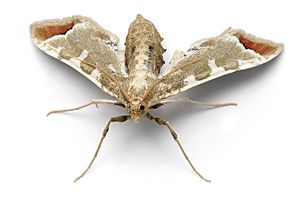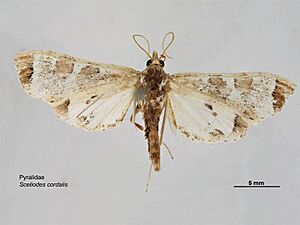Poroporo fruit borer facts for kids
Quick facts for kids Poroporo fruit borer |
|
|---|---|
 |
|
| Scientific classification | |
| Kingdom: | |
| Phylum: | |
| Class: | |
| Order: | |
| Family: | |
| Genus: |
Leucinodes
|
| Species: |
L. cordalis
|
| Binomial name | |
| Leucinodes cordalis (Doubleday, 1843)
|
|
| Synonyms | |
|
|
Leucinodes cordalis, also known as the poroporo fruit borer or eggfruit caterpillar, is a type of moth. It belongs to the Crambidae family. You can find this moth in countries like New Zealand, Australia, and Indonesia (specifically Sulawesi). In Australia, it has been seen in many places, including Norfolk Island, the Northern Territory, Queensland, New South Wales, the Australian Capital Territory, Victoria, Tasmania, and South Australia. Henry Doubleday first described this species in 1843.
What Does This Moth Look Like?
The Leucinodes cordalis moth has forewings that are about 13.5 to 15 millimeters long. That's roughly the length of a small paperclip!
Their forewings are mostly off-white. They have brown tips and a pattern of pale brown blotches. This coloring helps them blend in with their surroundings.
Life Cycle and Diet
These moths have different numbers of generations each year. In New Zealand, there are usually two generations. This means they complete their full life cycle twice in one year. In Australia, there might be even more generations.
What Do the Larvae Eat?
The young moths, called larvae or caterpillars, are bright pink. They can grow to be about 20 millimeters long. These larvae are known for boring into the fruit of plants. They then feed on the soft inside parts and the seeds.
They especially like plants from the Solanum family. Some of their favorite foods include:
- Eggplant (Solanum melongena)
- Solanum muricatum (also known as pepino)
- Solanum aviculare (poroporo)
- Tomato (Solanum lycopersicum)
- Solanum esuriale
- American black nightshade (Solanum americanum)
- Potato (Solanum tuberosum)
- Capsicum annuum (which includes bell peppers and chili peppers)
They also feed on plants from the Datura genus, such as Datura wrightii and Datura stramonium.
See also



